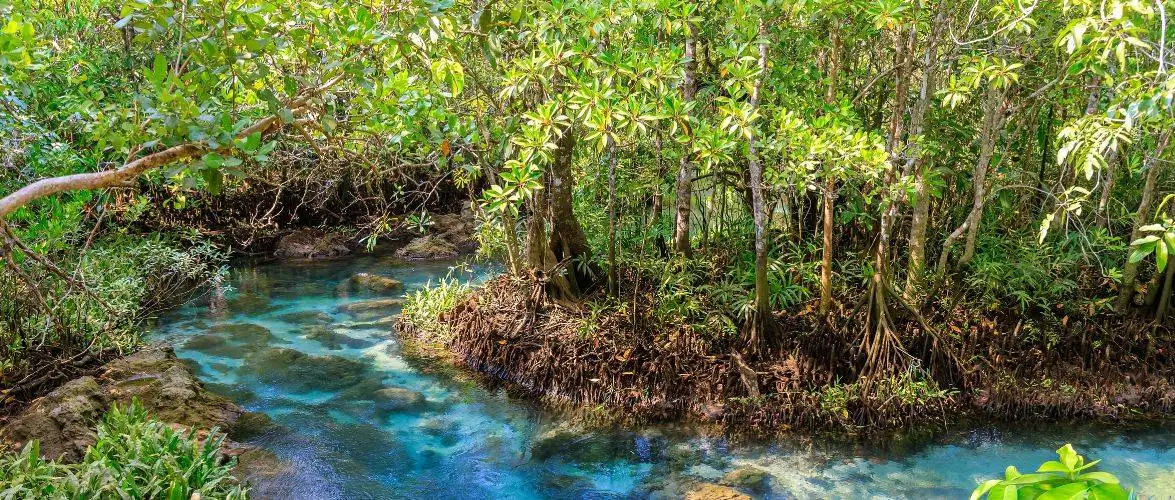Harbouring The Economic Potential of Mangrove-Based Ecosystems
An Overview:
- Mangroves can miraculously filter out salt and excrete the residue through their leaves, aerial roots, and specialised root systems.
- Aquaculture, carbon mitigation, forest raw material production and honey bee farming are the key perks of deploying mangroves within a nature-based economy.
- Thriving bee colonies are of great economic value for beekeepers and farmers.
- Over the years mangrove conservation and restoration has had a significant positive impact on local communities, economies, and the ecosystem like Indonesia.
Mangroves – The Miracle of Nature:
Studies suggest that approximately 97.5% of the world’s total water volume is saltwater, while only 2.5% is freshwater. This means that most of the Earth’s water is not suitable for human consumption or use in agriculture, and only a small fraction of the world’s water resources is available for these purposes. Given such an adverse condition of the world’s water bodies, Mangroves are no less than a miracle because they are a group of salt-tolerant trees and shrubs that grow in coastal intertidal zones, brackish water, and swamps in tropical and subtropical regions.
They have unique adaptations that enable them to survive in harsh coastal environments, including the ability to filter out salt and excrete the residue through their leaves, aerial roots, and specialised root systems. These miracle trees also provide habitat and food for a wide range of marine and terrestrial species, as well as providing protection from coastal erosion, storms, and tsunamis. They are also critical for carbon sequestration and play a significant role in mitigating the impacts of climate change.
Benefits Of Deploying Mangroves – Nature Based Economy
Nature-based economies rely on the sustainable use and management of natural resources and ecosystems to support human well-being and economic development. Many such countries who follow this approach recognize the intrinsic value of Mangrove plantation offer a range of economic benefits that are vital for coastal communities.
I. Fisheries and Aquaculture: The breeding and feeding habitats provided by Mangroves are crucial for the survival of various fish and shellfish species, which can in turn be commercially harvested to support the local fisheries and aquaculture industries. This can result in income and employment opportunities for the local communities.
II. Credits Through Carbon Mitigation: Mangrove forests have the potential to remove substantial quantities of carbon dioxide from the air, thereby aiding in the fight against climate change. By segregating carbon, mangroves can generate carbon credits that serve as a supplementary source of revenue.
III. Production of Valuable Forest Produce: Mangroves can serve as a valuable source of both timber and non-timber forest products, including medicinal plants and charcoal. By tapping into these resources, local communities create new employment opportunities and generate income.
IV. Honey Bee Farming: Due to a large flower product that is rich in nectar, Mangroves become a reliable source of nectar for bees, especially during seasons when other flowering plants may not be in bloom. Mangroves also provide a natural shelter for bees, protecting them from harsh weather conditions and predators. Thriving bee colonies are of great economic value for beekeepers and farmers.
Harnessing The Power of Mangroves – Case Studies:
Given the economic and ecological benefits of Mangrove trees, they have increasingly become an important strategy for coastal countries to address a range of environmental and economic issues. Following are three case studies that demonstrate the significant positive impact that mangrove conservation and restoration can have on local communities, economies, and the ecosystem:
- In the early 2000s, Thailand’s Royal Forest Department launched a project aimed at restoring Mangrove forests in the country’s coastal areas to reduce coastal erosion, protect local communities from natural disasters, and provide sustainable livelihoods for local people. Over several years, the project planted over 10 million Mangrove trees, restoring over 5,000 hectares of mangrove forest. This effort has improved local fisheries, reduced the impacts of coastal erosion, and provided sustainable economic benefits to local communities. (Source: https://www.zsl.org/ )
- Indonesia’s Community-Based Forest Management (CBFM) program was launched in 2002 to empower local communities to manage and protect their forest resources, including mangrove forests. This initiative has helped establish over 600 community forestry groups across Indonesia, some of which focus on mangrove conservation and restoration. The program has successfully planted millions of Mangrove trees, improving local fisheries, and providing sustainable economic benefits to local communities. (Source: https://www.wrm.org.uy/ )
- The Philippines’ Integrated Coastal Management (ICM) program, launched in 1995, is a national initiative aimed at promoting sustainable coastal management practices, including mangrove conservation and restoration. This program has led to the planting of over 20 million mangrove trees in the country and has been credited with reducing coastal erosion, improving local fisheries, and providing sustainable economic benefits to local communities. (Source: https://www.fao.org/home/en/ )
Our Impact Partner – The Green Pillar Foundation is Creating Nature-based Solutions Via Mangroves:
The Prasiddhi Forest Foundation (impact partner of TGP) has been dedicatedly working towards Mangrove plantation and recognizes the potential of Mangrove towards the benefit of economies. Under our new initiative The Green Pillar that is a network for individuals and groups working in tandem for the restoration and betterment of nature, we intend to promote the use of nature-based solutions by utilising natural systems or processes to address environmental challenges, such as climate change, large scale soil erosion, among other issues. The Green Pillar foundation will also be supporting nature-based solutions via mangrove plantation drives on a large scale across India. If you would like to be a part of our journey to #HealOurEarth you can visit thegreenpillar.com.








